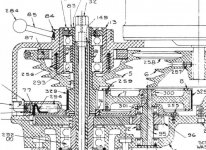aribert
Cast Iron
- Joined
- Jul 2, 2008
- Location
- Metro Detroit, MI
Greeting all:
I typically lurk here on PM and post on the HSM forum. But I figured the knowledge base on this forum might be greater. In the 15+ years I've owned my existing J-head B'port, I only lubed the head - no other service has been needed.
I am building up a replacement B'port (my existing J-head step belt is a 1 hp w/ a 32 inch (not a typo) table - I've outgrown the small table). The new machine has a 42 inch table. I bought the head for the new machine at an estate sale 18 months ago - configured with a 1.5 hp motor that spins the head at twice the speed of a standard step belt B'port. Finally acquired a B'port missing its head so now I have married the two and am beginning to debug the head.
Since the head had been out of service for several years or more, I (over)lubed the head before running it under power. Under power, the new to me J-head makes a irregular rattling sound. In comparison, my existing B'port (with the belt in the same position on the pulleys) is very quiet. With the v-belt loosened there is noticeable backlash in the spindle step belt pulley. My existing (quiet head) does not exhibit any backlash on the same pulley.
I expect to dismantle the upper portion of the head in a day or so to investigate but I figured I would ask here for any guidance. Looking at the B'port exploded view, it appears that the step belt pulley is keyed to the "spindle pulley hub". Is this correct? If so, I'm hoping that all I need to do is to recut the keyway in the aluminum step pulley. I found on line a B'port J-head rebuild procedure published by Industrial Tool and Machineworks. Any other references I should look at / be aware of?
I typically lurk here on PM and post on the HSM forum. But I figured the knowledge base on this forum might be greater. In the 15+ years I've owned my existing J-head B'port, I only lubed the head - no other service has been needed.
I am building up a replacement B'port (my existing J-head step belt is a 1 hp w/ a 32 inch (not a typo) table - I've outgrown the small table). The new machine has a 42 inch table. I bought the head for the new machine at an estate sale 18 months ago - configured with a 1.5 hp motor that spins the head at twice the speed of a standard step belt B'port. Finally acquired a B'port missing its head so now I have married the two and am beginning to debug the head.
Since the head had been out of service for several years or more, I (over)lubed the head before running it under power. Under power, the new to me J-head makes a irregular rattling sound. In comparison, my existing B'port (with the belt in the same position on the pulleys) is very quiet. With the v-belt loosened there is noticeable backlash in the spindle step belt pulley. My existing (quiet head) does not exhibit any backlash on the same pulley.
I expect to dismantle the upper portion of the head in a day or so to investigate but I figured I would ask here for any guidance. Looking at the B'port exploded view, it appears that the step belt pulley is keyed to the "spindle pulley hub". Is this correct? If so, I'm hoping that all I need to do is to recut the keyway in the aluminum step pulley. I found on line a B'port J-head rebuild procedure published by Industrial Tool and Machineworks. Any other references I should look at / be aware of?














